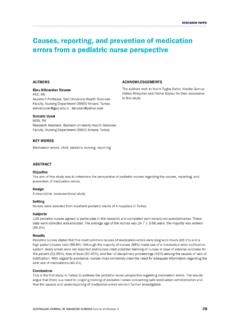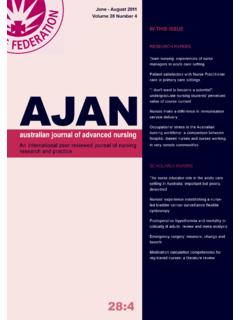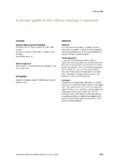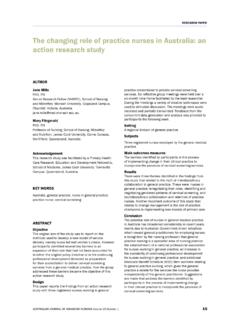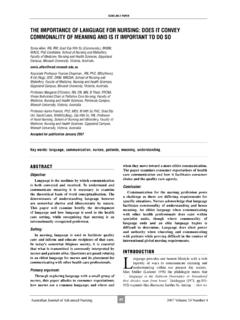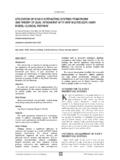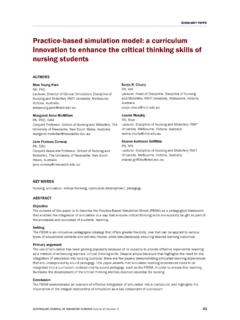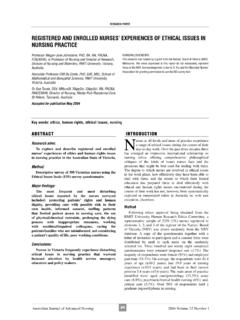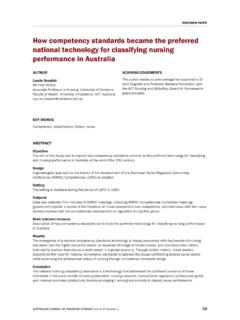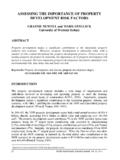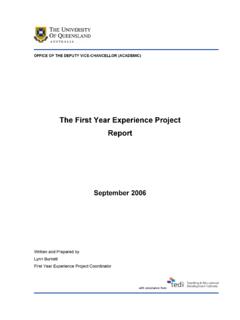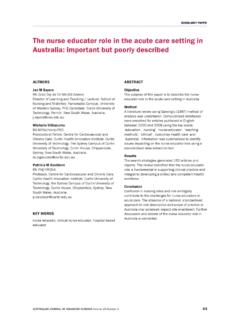Transcription of THE IMPACT OF HOSPITAL STRUCTURE AND …
1 42 Australian Journal of Advanced Nursing 2007 Volume 24 Number 3 RESEARCH PAPERA ustralian Journal of Advanced Nursing 2007 Volume 24 Number 4 RESEARCH PAPER43 THE IMPACT OF HOSPITAL STRUCTURE AND RESTRUCTURING ON THE NURSING WORKFORCEP rofessor Christine Duffield, RN, PhD, Director, Centre for Health Services Management, University of Technology, Sydney, Mark Kearin RN, MHSM, Area Manager, Nursing careers and professional development, Directorate of Nursing and Midwifery, North Sydney Central Coast Health, Professor Judy Johnston PhD, Associate Professor, School of Management, University of Technology, Sydney, Joanna Leonard, BA (Comm), Equity and Diversity Officer, Equity and Diversity Unit, University of Technology, Sydney, Australia. Accepted for publication December 2006 Key words: HOSPITAL STRUCTURE , restructuring, nursing, managementABSTRACTO bjective: Health systems throughout much of the world have been subject to 'reform' in recent years as countries have attempted to contain the rapidly rising costs of health care.
2 Changes to HOSPITAL structures (restructuring) have been an important part of these reforms. A significant IMPACT of current approaches to restructuring is the loss of, or changes to, nursing management roles and : Australian hospitals Primary argument: Little evaluation has been undertaken to determine the IMPACT of HOSPITAL STRUCTURE and organisational restructuring on the nursing : There is some indication that nurses have experienced a loss of key management positions, which may IMPACT on their capacity to ensure that adequate and safe care is provided at the ward demand for efficiency in health care has resulted in significant and, too frequently, continuous changes to HOSPITAL structures. Mergers, downsizing and re-engineering, all of which may include changes in work assignments, modifications to clinical staffing and skill mix, and reductions in management positions, are commonplace.
3 Often these strategies have been driven by factors external to the health service itself such as decreased funding or the introduction of a new or expanded service. In the Australian context we can also add political imperatives such as: a strengthening of the federal government s inf luence in health; the need to better integrate and coordinate health services; increased expectations of consumers for accountability; and media coverage of adverse HOSPITAL outcomes such as occurred recently at Bundaberg HOSPITAL (Queensland) or the Macarthur Health Service (New South Wales). The IMPACT of restructuring on staff is not necessarily accounted for in the process of change, which is unfortunate, as the pressures of cost containment usually lead to an emphasis on work redesign to deliver care in more efficient and cost effective ways.
4 However as hospitals undergo restructuring there is little evidence that efficiency or outcomes actually improve (Fulop et al 2002; Braithwaite et al 2005). Despite this, restructuring can have significant implications for patients and the nursing patients, decreased bed numbers and bed block have resulted in shorter stays in HOSPITAL , increased rates of day only admissions and longer waiting times. Patients are likely to be sicker on admission and as a consequence, require more care. It is now well established that patient outcomes are linked to appropriate nurse-patient ratios and the proportion of registered nurses (Aiken et al 2002). Hospitals in which the organisation of nursing promotes high levels of nurse autonomy, nurses control over their work environment, and good relationships between nurses and doctors, have better patient outcomes (Sochalski and Aiken 1999).
5 These factors are also associated with greater trust in management and a greater commitment from nurses to their work place (Laschinger et al 2000).However nurses as the largest component of the workforce and thus the largest operating expenditure, are often faced with restructuring which involves reducing their labour costs through changes to skill mix and work practices and a reduction in management positions. Hospitals are now less likely to have enough registered nurses, adequate support services, supervisors who are supportive of nursing, an inf luential chief nurse executive, and other organisational characteristics associated with good patient outcomes (Upenieks 2003). It is timely therefore to consider in more detail the IMPACT of restructuring, an almost constant occurrence in today s health care system, on nurses who ultimately provide the majority of patient the complexity of providing health services presents different challenges in structuring for the best results (effectiveness) and the greatest return on investment (unit cost) than in many other service industries.
6 Health care administrators have been pressured to undertake almost constant organisational restructuring due to a range of dynamic external factors including: increasingly scarce resources; rapidly developing and costly technology; shifting consumer expectations; a changing workforce; new regulations and competition; and demands for greater efficiency (McConnell 1998; Keating 2000). In addition, as with other public sector organisations, governments adoption of a market-based model has reinforced the need for more efficient ways of organising (Self 1993).A range of contemporary managerial ideas including: total quality management; the use of teams; process re-engineering, patient focused care; decentralisation of services; and high performance work organisations; have impacted on the organisational design of hospitals and health services (Landsbergis et al 1999).
7 While these generic business oriented approaches are persuasive, the extent to which they are effective in health is unknown. Hospitals, which constitute a significant proportion of health services expenditure, have sought to increase efficiency, decrease duplication, and re-shape the way that care is delivered through whole systems restructuring (Urden and Walston 2001). Generally however there is widespread dissatisfaction with this market-based approach from nurses, with its strong emphasis on organisational management and efficiency, rather than on nursing practices that have been shown to lead to better patient outcomes (Urden and Walston 2001). Organisational change should result in a more patient-centred system emphasising goal alignment amongst all clinicians (not just nurses) and managers, and devolved decision making that supports improvement in satisfaction, quality, cost, innovation and growth (Miller et al 2001).
8 Indeed there are some who argue that the new, leaner, restructured health system has replaced earlier models which were traditionally characterised by high job satisfaction; adequate staffing; clinical career ladders which fostered retention; a degree of autonomy, responsibility and control at a practice level; lower staff turnover; and superior patient and nurse safety outcomes (Aiken et al 2001).A common market-based model for restructuring to increase efficiency has been downsizing. This process usually involves an overall reduction in staff numbers, centralisation of administrative functions to reduce overheads and duplication, and removal of middle layers of management (Roan et al 2002). The current target is white-collar professionals rather than blue-collar workers, making nursing staff especially vulnerable (Di Frances 2002).
9 As Aiken et al (1996) report, a result of downsizing of hospitals in the USA was that the number of nurses declined while the number of non-clinical administrators increased. Hospitals continue to f latten their structures with fewer nurse management positions and wider spans of control in an ongoing effort to cut costs (Laschinger et al 2001).Restructuring in AustraliaAustralia is not immune to the trend to restructure. For several years now there has been a shift toward an organisational STRUCTURE that involves managing a network of inpatient, outpatient, community and support services at the HOSPITAL level. This grouping of related specialties is commonly referred to as clinical divisions or directorates. More recently the trend in New South Wales has been to streams of care.
10 Clinical streaming builds on the model of networking of services and focuses on the provision of services across the care continuum and across a number of settings and institutions with a senior clinician (usually medical) responsible for service services usually encompass everything from health promotion, early intervention, community health and outpatient services, through to acute and intensive care. Clinical streams are meant to facilitate the participation by all clinicians as well as consumers in the planning, development and improvement of services and to assess the best way to use available resources (human, financial and infrastructure) to meet client needs (NSW Health 2004). Despite these intentions, the changes have not always united clinicians as specialist interests sometimes become even more strongly focused, leading to competition for resources and restricting integration (Braithwaite and Westbrook 2005).
